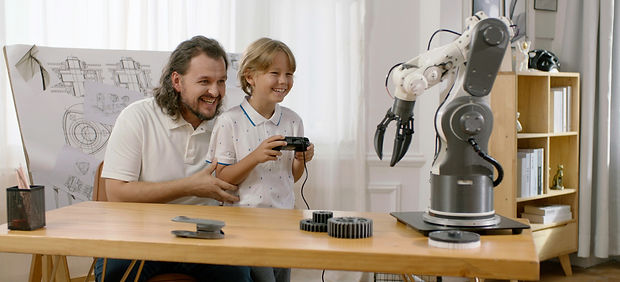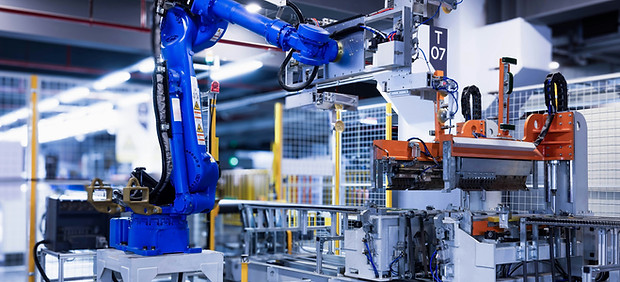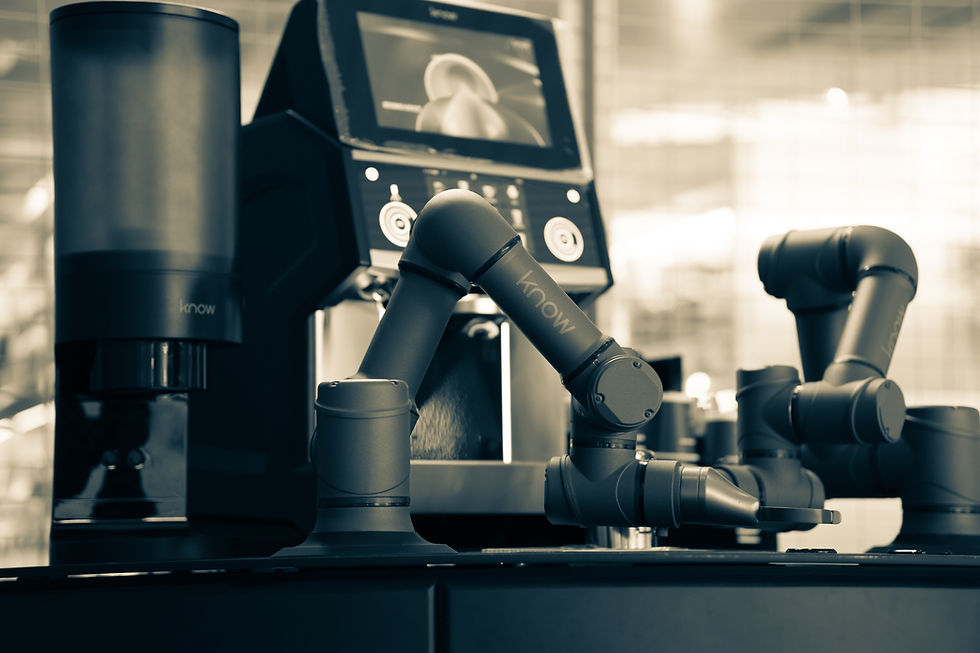Synria - a Revolutionary STEM Education Robot
Robotic arm is a very friendly entry robotic that students experience how to precisely control some of the actuators with coding and AI automations. WE use this tool to excel students' creativity and innovation in turning ideas into actual motion in physical world, to sooth some issues with repetitive, labour-intensive or dangerous working process, with robotics.
Why choose " Synria "?

One-machine learning,
multi-disciplinary applications
Robotic Artificial Intelligence and Humans
The widespread adoption of artificial intelligence and robotic automation, even potentially replacing some human jobs, will pose a threat to the next generation. Enabling students to understand, master, and utilize relevant technologies early on is crucial for inspiring them to reflect on their own value and talent.

Connecting to future industrial development
Robotic arms are the most mature and widely used smart terminals in industry and daily life. From automobile manufacturing to mobile phone assembly, from Amazon to JD warehouses, from semiconductor manufacturing to medical experiments, robotic arms are everywhere. By learning about robotic arms , students can not only master skills such as mechatronics, program control, and AI perception, but also pave the way for future workplaces and connect to hot fields such as smart manufacturing, robotics, and AI industries.

More possible campus applications
From automated sorting demonstrations, intelligent book arrangement, laboratory experiments, coffee-making, to maker creation and human-computer interaction performances, the flexible intelligent robotic arm brings diverse application opportunities to teaching.

Cultivate problem-solving thinking
The INSPIRE team used a premise that was close to the daily life of the school as the topic, inspired students to observe and analyze the problems through the design thinking guidance workshop, and tried to use Synria It is the carrier of the operation plan, using the configured AI image analysis and advanced sensors to complete the task.

Extremely expandable mechanical structure
We provide a variety of installation solutions and related secondary development materials, allowing you to flexibly match different usage scenarios and integrate them into your projects, applications, and even life.

Why Choose Synria?

Combining the latest scientific research technology in the 21st century
The Synria robotic arm supports imitation learning and VLM algorithm training, Isaac Gyn enhanced learning control, 2D/6D single-arm grasping, and other technologies. Each of these technologies has enormous application development potential, allowing students to experience the application of high-end technologies earlier than others and gain a richer experience than their peers.
Imitation learning and VLM algorithm training
Synria is a high-performance teleoperated robotic arm platform designed for imitation learning and VLM algorithm training scenarios. It can meet the needs of researchers, developers, and technology enthusiasts to explore the VLA (Vision-Learning-Action) paradigm.
Isaac Gym reinforcement learning control
Powered by the NVIDIA Isaac Gym platform, Synria implements end-to-end intelligent control strategies through reinforcement learning algorithms. The robotic arm rapidly learns grasping, manipulation, and task planning in a simulated environment, demonstrating high adaptability and decision-making capabilities, demonstrating a new paradigm in AI-driven robotics.
2D/6D single-arm grasping
Synria supports multi-level vision-guided grasping tasks, from 2D to 6D. By integrating a high-resolution RGB camera and a depth camera, the system can achieve accurate recognition and spatial positioning of target objects.
Remote control master-slave control
Synria provides a complete dual-arm teleoperation solution, supporting high-frequency motion capture and synchronized execution. The system is fully compatible with the LeRobot recording format, facilitating imitation learning data collection and multi-model comparative training.
Overview of practical applications and workshops
From experience to control, and then inspire creativity
01 / Technical Foundations (Know the Tech) [ Recommended 3-4 hours ]
-
Understanding the Existing Process: Students carefully analyze the complete production process for a task, along with the standard operations and workflow for each step.
-
Feasibility and Limitation Assessment: Students will explore the feasibility and limitations of using a robotic arm to replace human labor, and discuss whether human actions can be translated into programs.
-
Related Technical Foundations: Students learn about the operating principles of robotic arms, sensor applications, control methods, and the potential for integration with vision modules.
02 / Hands-on Development [ Recommended 6-8 hours ]
-
Mechanical Assembly: Students will personally assemble a gripper, AI camera module, and control components, understanding the structure and functions of the robotic arm components and experiencing the engineering development process.
Practical Projects
-
Voice-Controlled Object Grasping
-
Programming a robotic arm to recognize voice commands and grasp corresponding objects.
-
Using an AI camera to train a model for object recognition.
-
Connect to the GUI to set up multi-point trajectories (waypoints) for automated movement.
-
Configure a target collection box to collect and identify objects.
Programming and Testing: Write and debug the code to control the robotic arm. Calibrate the robotic arm joints, adjust gripper accuracy, and synchronize vision and motion. Test system performance and make fine-tuning adjustments based on the results.
-
-
Error Analysis and Improvement: Students record observed errors, adjust strategies, and propose improvements to hardware design or programming.
-
Modifying the Robotic Arm: If necessary or desired, 3D print parts to achieve tasks or improve efficiency.
03 / Design Thinking & Use Case Showcase [ Recommended 3-4 hours ]
-
Learn and practice design thinking training
-
Reverse Thinking: Convert human arm movements into executable programs for the robotic arm.
-
Problem Exploration: Observe the campus environment and identify pain points or unmet needs (e.g., automating repetitive tasks, improving accessibility).
-
Root Cause Analysis: Analyze the core causes of a problem from multiple perspectives, taking into account the needs and perspectives of various stakeholders (e.g., students, faculty, and staff).
-
Concept Development: Utilize the Synria robotic arm or other robotic solutions as the core.
-
Prototype Testing: Rapidly build and test, fine-tune, and refine the robotic arm's application model.
-
Small Project: Teams design and implement small robotic solutions to campus challenges.
-
Publication: Students present their solutions to the entire school through presentations, live demonstrations, and other methods.
Government program application support
The government currently provides funding for Hong Kong primary and secondary schools through the IT Innovation Lab and IT Fun Learning programs. These programs aim to foster students' interest in, understanding of, and application of information technology through extracurricular activities, fostering their integration into the knowledge-based economy and digital society. The purchase of the Synria robotic arm and the accompanying workshop courses described above qualify for these programs, allowing schools to apply for subsidies of up to over 200,000 Hong Kong dollars. Current applications for robotic arms include:
Activity Name | Equipment Cost | Operating Expenses | Funding Amount ($) |
|---|---|---|---|
Designing Robotic Arm Application (Workshops for S1 – S3 students) | 116900 | 64000 | 180900 |
Live Applications of Robotic Arms Computer Vision and Artificial Intelligence (Short courses/ training for S1-S3 students) | 60000 | 104000 | 164000 |
Designing Robotic Arm Application (Workshops for S1 students) | 133400 | 64000 | 198400 |
Applications Related to Artificial Intelligence and Robotic Arm Programming (Short courses/ training for S3-S5 students) | 180600 | 0 | 180600 |
Designing Robotic Arm Application (Short courses/ training for S2 students) | 104400 | 64000 | 168400 |
Designing Robotic Arm Application (Short courses/ training for S1-S3 students) | 0 | 197600 | 197600 |
A student programmable robotic arm with machine learning and artificial intelligence capabilities (Short courses/ training for S3 students) | 134400 | 241920 | 376320 |
2015
• INSPIRE’s founder began promoting the DJI Phantom 2 in schools, creating a comprehensive course on safe operation and legal compliance.
2017
• Expanded drone curriculum to include 360° panorama, 3D mapping, and other practical applications.
• Developed custom drone programming materials in response to the launch of Tello EDU.
2020
• Partnered with HKPC to host large-scale online workshops during COVID, engaging 120 students in live programming and real-time flight demonstrations.
• Continued providing STEM courses across schools, including drone coding, aerial filming, multimedia workshops, and 3D modeling/printing.
2021
• Collaborated with DJI to launch the DJI-R-Club, promoting RoboMaster S1 and Tello Talent through free and paid workshops for students and parents.
2024
• Partnered with the Education Bureau to use Tello Talent in creative confidence-building activities for autistic students, culminating in a drone light show.
• Launched “Gen AI Applications” workshops:
– Co-organized 4 public sessions with HKtag to support “Smart Campus” and “Open Data Hackathon” projects.
– Taught AI prompting, knowledge base structuring, and LLM applications.
• Promoted “Design Thinking” in primary schools, making it more accessible and inspiring students through coding and innovation.
Behind these achievements lies INSPIRE's unwavering commitment to the principles of "curiosity, creativity, and courageous action." Composed of young professionals graduating from renowned Hong Kong universities, the team is deeply engaged in education and innovation, actively guiding students to think outside the box and embrace learning.
What can we offer you?
1. Complete teaching support: curriculum design, teaching materials, teacher training, and hardware support.
2. Project Consulting Services: From curriculum planning to campus application solutions, tailor-made.
3. Hardware/Software Technical Services: We provide genuine robotic equipment and comprehensive technical guidance.
4. Competition Coaching: Assist teachers and students to participate in inter-school robotics competitions and improve their practical skills.
5. Cooperation with government funding: We can connect with middle school IT innovation labs, primary school "Funny IT Learn More" and other programs to help you apply for and use relevant funds.

Inspire with action, ignite with innovation, and lead the next generation into the future with INSPIRE!
Further Enquiries
Want to promote robot and AI education on campus? Fill out the form below or contact us now. Let INSPIRE and MakerSoulHK provide a personalized solution for your school and bring the most advanced and engaging learning experience to your students and teachers.

